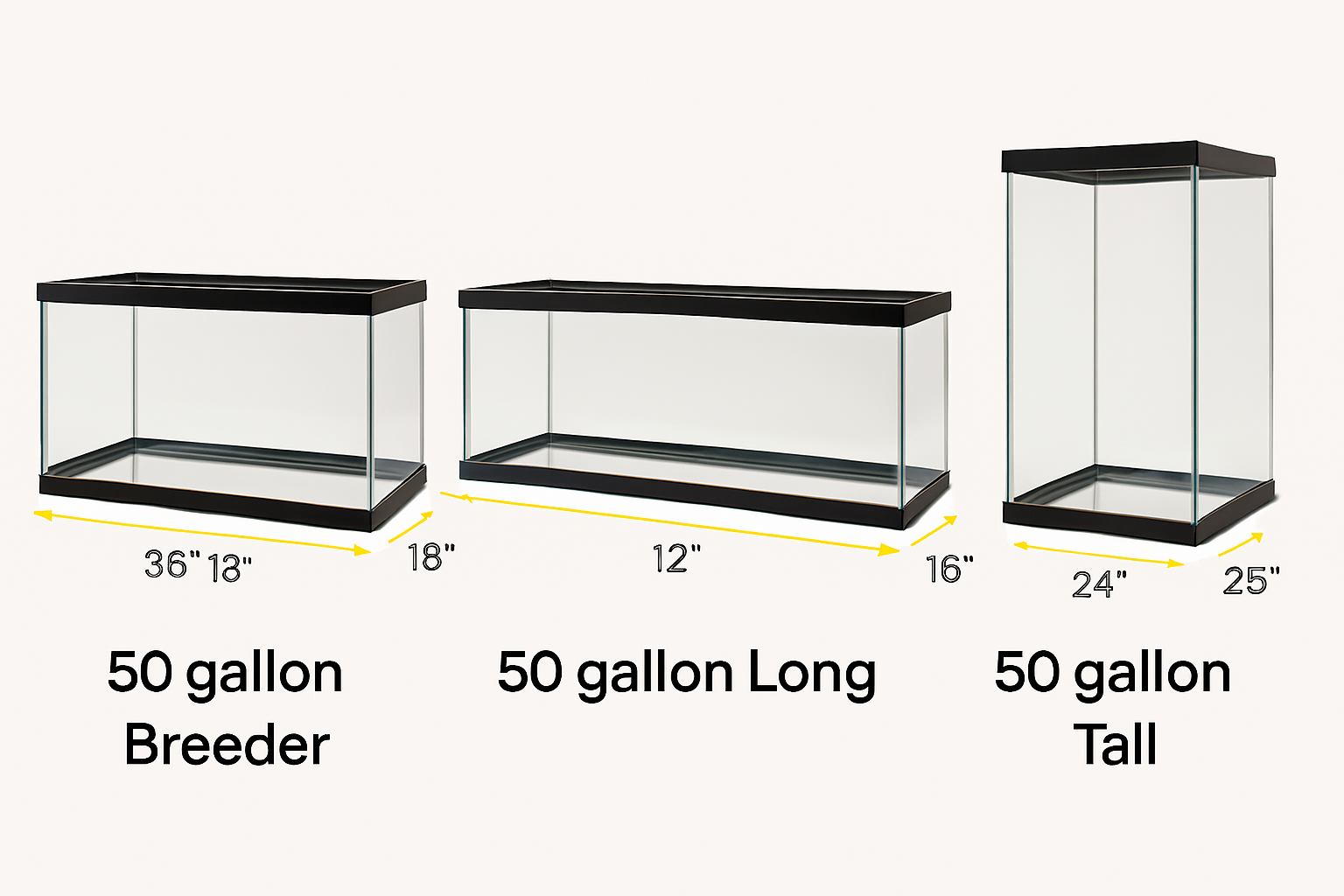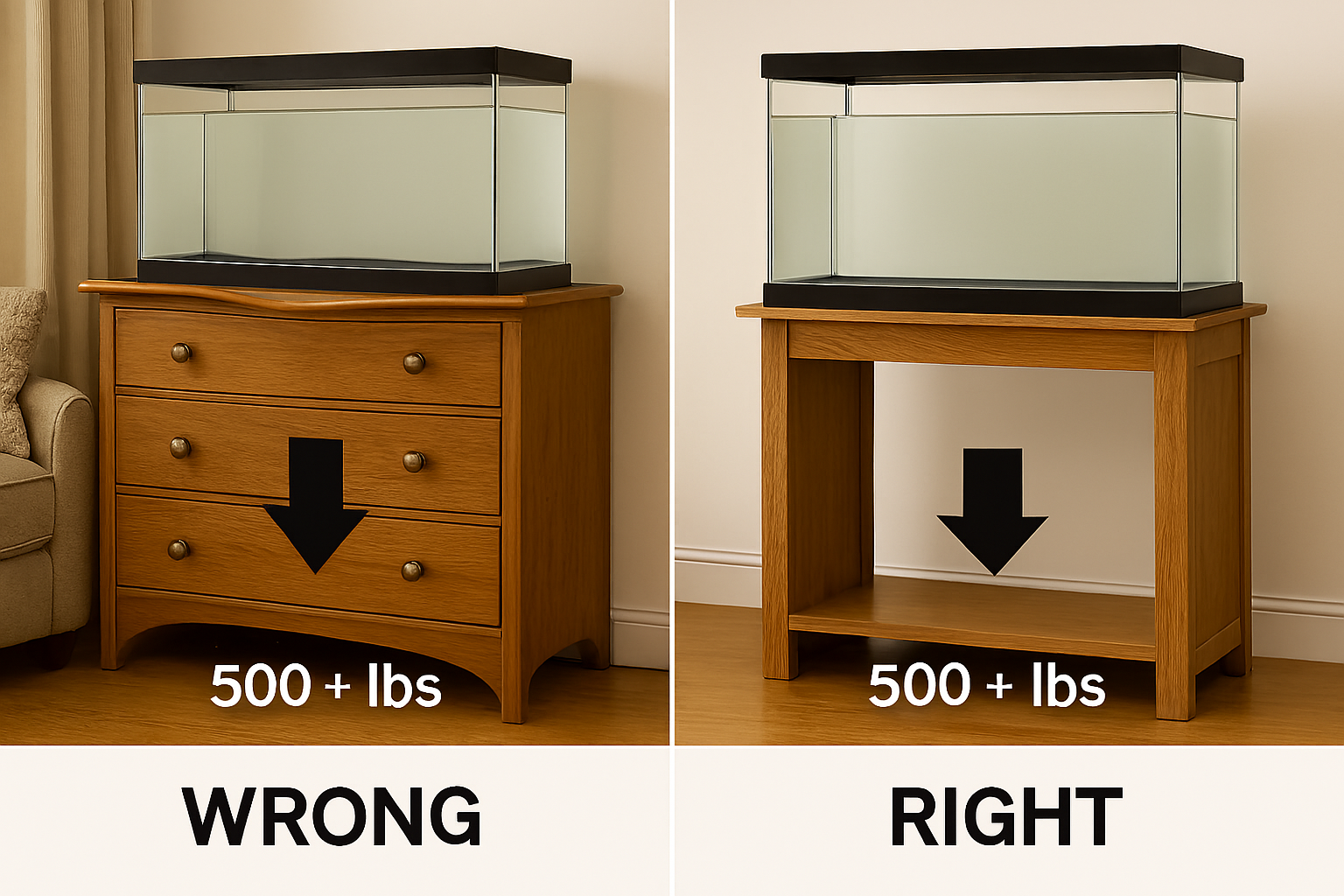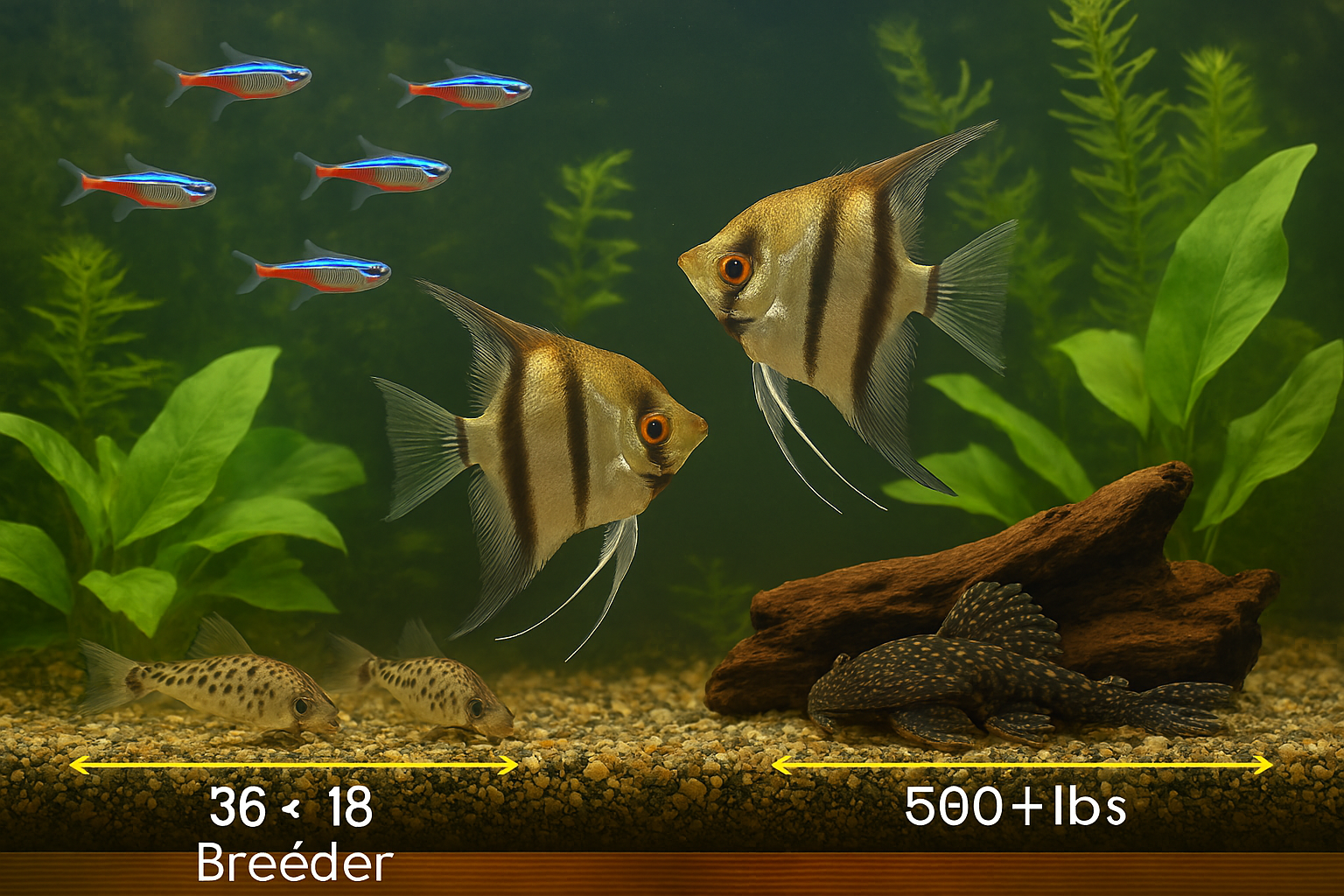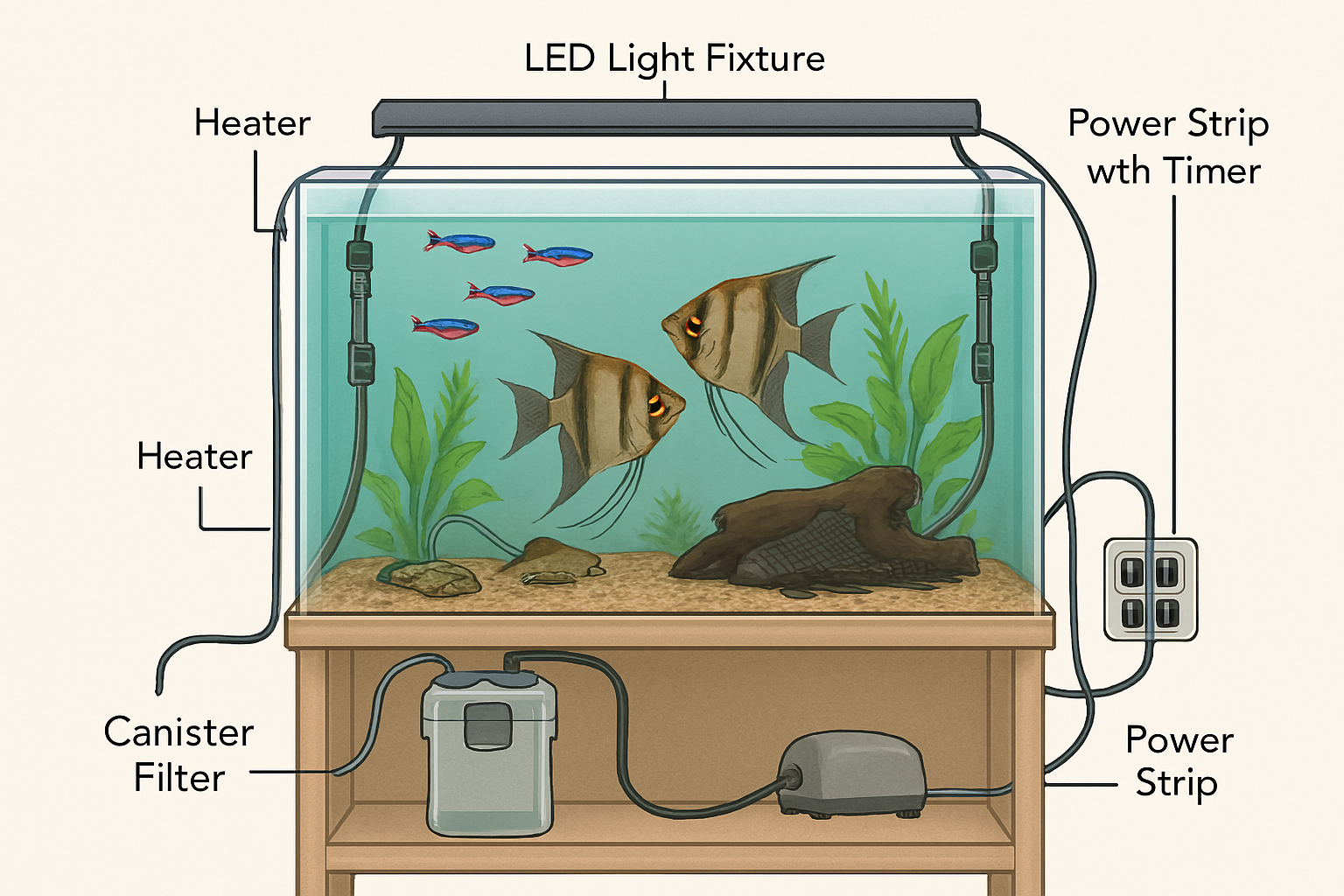When I decided to upgrade from my little 10-gallon starter tank, I thought a 50-gallon would be perfect. Had this vision of it sitting nicely on my dresser. Yeah, that didn’t work out. Turns out I had no clue how much space these things actually take up.
A standard 50-gallon fish tank measures about 36 inches long, 18 inches wide, and 19 inches tall. But here’s what nobody tells you – you need way more space than just those dimensions. Learned this the hard way when I tried squeezing mine into a spot that was exactly 36 inches wide.
The Reality of 50 Gallon Tank Dimensions

Most 50-gallon tanks come in what’s called a “breeder” style, which means they’re longer and wider but not as tall as some other tank shapes. The standard dimensions I mentioned work out to roughly 3 feet long, 1.5 feet wide, and about 1.5 feet tall.
But here’s where it gets tricky – different manufacturers make slightly different sizes. I’ve seen 50-gallon tanks that were 48 inches long but only 12 inches wide. These “long” tanks have the same water volume but completely different footprints.
My current tank is the standard 36x18x19 size, and it weighs about 100 pounds empty. Add water, substrate, decorations, and equipment, and you’re looking at close to 500 pounds total. That’s something I definitely didn’t think about when picking a location.
Weight Considerations That Caught Me Off Guard

Water weighs about 8.3 pounds per gallon, so 50 gallons of water alone is over 400 pounds. Add the glass tank, gravel, rocks, driftwood, and equipment, and you’re pushing 500-600 pounds easily.
I originally had my tank on a regular wooden dresser. Big mistake. Started noticing the dresser sagging after a few weeks, and I was terrified it was going to collapse. Ended up buying a proper aquarium stand, which was another $150 I hadn’t budgeted for.
The floor underneath needs to be solid too. My apartment has old wooden floors, and I actually called my landlord to make sure the floor could handle the weight. Better safe than sorry, especially since water damage would’ve been my responsibility.
Space Requirements Beyond Just the Tank
You need clearance around the tank for maintenance, equipment, and just basic access. I learned this when I realized I couldn’t reach the back corners to clean algae because I’d pushed the tank too close to the wall.
The filter, heater, and air pump need space too. My canister filter sits in the cabinet below the tank, but the intake and output tubes stick out the back. Power cords need somewhere to go. If you’re using a hang-on-back filter, add another 6 inches to your depth requirements.
I also need space to set buckets during water changes. Can’t tell you how many times I’ve knocked stuff over trying to maneuver a 5-gallon bucket in a tight space.
Different Tank Shapes and Their Trade-offs
The standard 36x18x19 tank is great for most fish, but it’s not the only option. I’ve seen 50-gallon “tall” tanks that are more like 24x18x25. These take up less floor space but are harder to maintain because you can’t reach the bottom easily.
Long tanks (48x12x16 or similar) are amazing for fish that need swimming room, like danios or barbs. But they’re harder to fit in most rooms because of that 4-foot length.
Cube-shaped 50-gallon tanks exist too, though they’re less common. These are roughly 22x22x22 inches. They look cool but aren’t great for most fish since the swimming area is limited.
What Actually Fits in a 50 Gallon Tank

This is where the size really matters. A 50-gallon tank gives you way more stocking options than smaller tanks, but you still can’t just throw any fish in there.
I keep a small school of tetras, a couple of angelfish, some corydoras catfish, and a bristlenose pleco in mine. The angels need the height, the tetras need the swimming room, and the bottom fish need the floor space.
You definitely can’t do large cichlids or anything aggressive that needs territory. I made that mistake early on with a jack dempsey that terrorized everything else in the tank.
For beginners, I always recommend community fish. Things like tetras, guppies, mollies, and corydoras work great together and don’t outgrow the tank.
Setting Up Your 50 Gallon Tank Space
Measuring the actual spot where your tank will go is crucial. I used masking tape to outline the tank dimensions on my floor before buying anything. Sounds silly, but it really helped me visualize the space.
Think about electrical outlets too. You’ll need several – one for the filter, one for the heater, one for lighting, maybe one for an air pump. I had to get a power strip with a timer for my lights.
Water access is another thing people forget. You’ll be doing 10-15 gallon water changes weekly, so having a sink nearby makes life way easier. My tank is in my living room, and carrying buckets from the kitchen gets old fast.
Equipment Considerations for 50 Gallon Tanks

The bigger tank means bigger equipment. My filter is rated for 75 gallons because you want some extra capacity. It’s about the size of a shoebox and needs its own space under the tank.
Heating a 50-gallon tank properly usually requires two heaters. I use two 150-watt heaters on opposite ends of the tank. This gives more even heat distribution and backup if one fails.
Lighting depends on what you’re planning to keep. For just fish, basic LED strips work fine. If you want live plants, you’ll need something more substantial. My current light fixture adds about 4 inches to the overall height of the tank setup.
Common Mistakes When Planning Tank Placement
Don’t put it near heating vents or air conditioning. Temperature swings stress fish out, and I learned this when my tank started fluctuating 10 degrees every time the heat kicked on.
Avoid direct sunlight too. Looks nice in theory, but you’ll get algae blooms constantly. My first tank was by a big window, and I was scraping green algae off the glass twice a week.
Leave room for a quarantine tank. Sounds excessive, but when you inevitably need to isolate a sick fish or acclimate new ones, you’ll want a smaller tank nearby. Mine sits on a shelf next to the main tank.
Maintenance Access and Ergonomics
Cleaning a 50-gallon tank means reaching into 19 inches of water regularly. If you’re not tall, this gets uncomfortable fast. I’m 5’6″ and sometimes need to use a step stool to reach the bottom back corners.
Gravel vacuuming takes forever compared to smaller tanks. Plan on spending 30-45 minutes on weekly maintenance instead of the 15 minutes a 20-gallon takes.
Having a dedicated fish room or area helps enormously. I converted a spare bedroom into my fish space, with storage for food, supplies, and quarantine tanks. Makes everything so much easier than spreading stuff around the house.
Cost Considerations Beyond the Tank
A proper stand for a 50-gallon tank runs $100-300 depending on style. Don’t cheap out here – you really don’t want 500 pounds of water crashing to your floor.
The initial setup cost surprised me. Between the tank, stand, filter, heater, lights, substrate, and decorations, I was into it for about $600 before buying a single fish.
Monthly costs aren’t terrible, but they add up. Water conditioner, fish food, replacement filter media, and electricity for running everything 24/7. Budget maybe $30-40 per month for ongoing expenses.
Comparing 50 Gallon to Other Common Sizes
Coming from a 10-gallon, the 50 felt massive. But after having it for two years, I sometimes look at 75-gallon tanks and think about upgrading. Funny how your perspective changes.
A 50-gallon is really the sweet spot for most people. Big enough for interesting fish communities, small enough to maintain without it taking over your life. A 75-gallon would give more stocking options but requires even more space and stronger floors.
Going smaller to a 30-gallon limits your fish choices significantly. The extra 20 gallons in a 50 opens up so many more possibilities.
What About Saltwater in a 50 Gallon Tank?
I’ve never done saltwater myself, but friends who have say 50 gallons is about the minimum for a meaningful marine setup. Saltwater fish generally need more space than freshwater, and the equipment requirements are more demanding.
The tank dimensions don’t change, but you need space for protein skimmers, refugiums, and other saltwater-specific equipment. Plus saltwater weighs slightly more than freshwater.
If you’re considering saltwater, definitely talk to experienced marine aquarists first. The space and cost requirements go up significantly.
Planning for Future Expansion
One thing I wish I’d considered more carefully is room to grow. Once you get into the hobby, you almost inevitably want more tanks. I now have three tanks in my fish room, and I’m running out of space.
If you have the room, consider leaving space for a second tank from the start. Having a hospital tank or breeding tank becomes really valuable once you get more involved.
Also think about storage space for supplies. Fifty-pound bags of salt, buckets of water conditioner, backup equipment – it all takes space you might not think about initially.
Is a 50 Gallon Tank Right for You?
Honestly, it depends on your situation. If you’re in a small apartment with weak floors, probably not. If you have a dedicated space and want to keep interesting fish communities, it’s fantastic.
Consider your long-term commitment too. A 50-gallon tank is a significant responsibility. You can’t just ignore it for a week like you might with a small goldfish bowl.
But if you have the space, budget, and interest, a 50-gallon tank opens up so many possibilities. The fish you can keep, the aquascaping options, the whole experience is just more engaging than smaller tanks.
Final Thoughts on 50 Gallon Tank Size
After two years with my 50-gallon setup, I’m really happy with the size choice. It’s big enough to be interesting but small enough that maintenance doesn’t take over my weekends.
The key is really planning the space properly from the start. Measure twice, buy once. Think about weight, access, electrical, and future needs before you commit.
And remember, the tank itself is just the beginning. The stand, equipment, and ongoing space needs are just as important as those basic dimensions. Plan for the whole system, not just the glass box holding the water.



